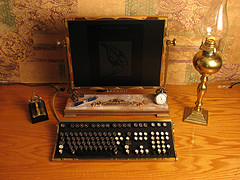I’ve been pondering the connection between the modding movement (particularly steampunk, of course) and the art of reliquary making from the Middle Ages (and before) a great deal lately, and thought I’d share some general thoughts. While I’m not technically an art historian, the subject has always fascinated me, and the connections between art and literature are, of course, myriad.
To begin, well, what is a reliquary? Simply put, a reliquary is a vessel, or housing, designed to fit holy objects–typically of a saint or a martyr–in order to enable worship, adoration, and experience. The actual structures varied immensely, from those small enough to house tiny locks of hair, teeth, and scraps of cloth, to large enough to compensate for entire bodies. While most people associate reliquaries with Catholic and Christian tradition, they are also very common in Hindu and Buddhist religions as well.
What initially astonished me about reliquaries, when I began studying the art of the Middle Ages in Western Europe, was the diversity and grandeur to be found in various examples. So much of the artwork during this period seems watered down, simplified, lacking in luster (to some… this is a point I’d argue rather vehemently). But the reliquaries dazzle with their ornate scrollwork, precious metals, inlaid stones, and sense of individuality (not to mention… oddity). That these reliquaries were so adored is no surprise; people believed they could work miracles! And in contrast to the day-to-day life of a medieval peasant, yes, I imagine I would have thought the same thing, too.
So, steampunk. Consider the word reverence:
1. a feeling or attitude of deep respect tinged with awe; veneration.
Now, is this day and age, religious homogenaiety is far from the norm. But we do revere our technology. And yet, alone, as a generic product of mass-production, our computers and iPods, our guitars, our phones–these things are not uniquely ours. Steampunk design has always striven to re-make, to re-apportion, to re-define the contents within. Because, like a finger-bone or lock of hair is indistinguishable without context, so too is your average computer/technology. Yet many of us feel compelled to read personalities into our own tech, striving to soften the edges of cold, hard, circuits. Granted steampunk artists tend to work in brass and wood, rivets and cogs, etc, and our medieval counterparts used gold, but the sentiment is surprisingly similar. Reliquaries house mysteries, and so, to some extent, to the mods of the steampunk aesthetic movement.
What’s particularly divergent when comparing the two is that while reliquaries and reliquary making were relegated to churches and those in control of power (and, some would argue, the Diety in general…), steampunk is almost like modding your own god. It brings to mind old practices of pagan “house gods”–the sorts that inhabit your kitchen, your hearth, your bedroom, the objects that you interact with every day. I mean, no medieval peasant would ever be able to afford their own reliquary–let alone a relic (thought I bet there were some pretty clever folks who made a pretty penny playing into the system). This diversion is at the heart of steampunk, that it’s something accessible rather than distant, something to be claimed rather than something that claims you. That’s why the best the concentration is on aesthetic–the look of the final project–rather than worth, i.e. much of steampunk material is scavenged, recycled, etc.
So, have our gods been replaced by the spirits of our machines? For some, maybe. But as different as people may be across milennia, it’s fascinating how much does indeed stay the same…
My personal favorite medieval reliquary, for those intrigued, is that of Saint Foi. Not only is she, essentially, a gold recreation (of sorts) of the original container for the bones (that would be Saint Foi herself), but the history behind the reliquary is fascinating and includes not only feuding medieval monks but also a series of thefts!
More shiny pretty reliquaries here, for those intrigued!


January 17, 2009 at 8:12 am
Have you ever read American Gods by Neil Gaiman? There are themes in the story that are similar to what you’ve touched upon with comparing the “old gods” to our new technology.
*hugs her iPod*
January 17, 2009 at 3:45 pm
Yes! Actually I was totally thinking about that when I was writing this. American Gods is one of my favorites of Gaiman’s, and definitely touches upon this. The neat thing about Steampunk, I think, is that it takes that concept to the next level, even. Pretty nifty.